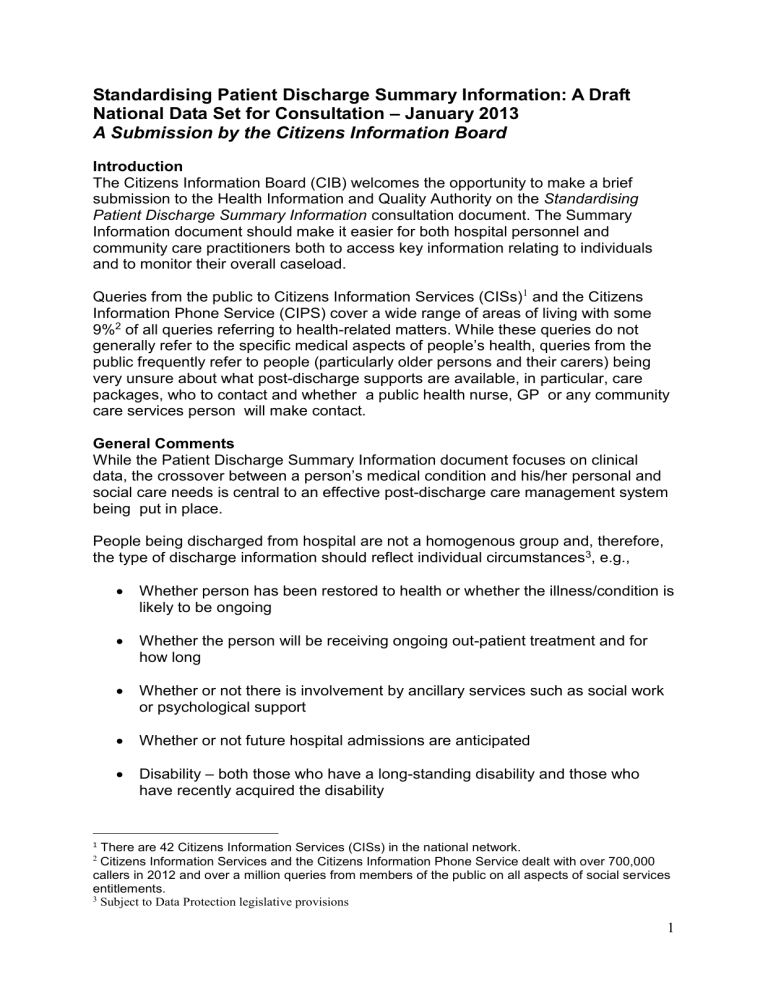Submission to HIQA on a consultation document on Standardising

Standardising Patient Discharge Summary Information: A Draft
National Data Set for Consultation – January 2013
A Submission by the Citizens Information Board
Introduction
The Citizens Information Board (CIB) welcomes the opportunity to make a brief submission to the Health Information and Quality Authority on the Standardising
Patient Discharge Summary Information consultation document. The Summary
Information document should make it easier for both hospital personnel and community care practitioners both to access key information relating to individuals and to monitor their overall caseload.
Queries from the public to Citizens Information Services (CISs) 1 and the Citizens
Information Phone Service (CIPS) cover a wide range of areas of living with some
9% 2 of all queries referring to health-related matters. While these queries do not generally refer to the specific medical aspects of people’s health, queries from the public frequently refer to people (particularly older persons and their carers) being very unsure about what post-discharge supports are available, in particular, care packages, who to contact and whether a public health nurse, GP or any community care services person will make contact.
General Comments
While the Patient Discharge Summary Information document focuses on clinical data, the crossover between a person’s medical condition and his/her personal and social care needs is central to an effective post-discharge care management system being put in place.
People being discharged from hospital are not a homogenous group and, therefore, the type of discharge information should reflect individual circumstances 3 , e.g.,
Whether person has been restored to health or whether the illness/condition is likely to be ongoing
Whether the person will be receiving ongoing out-patient treatment and for how long
Whether or not there is involvement by ancillary services such as social work or psychological support
Whether or not future hospital admissions are anticipated
Disability
– both those who have a long-standing disability and those who have recently acquired the disability
1 There are 42 Citizens Information Services (CISs) in the national network.
2 Citizens Information Services and the Citizens Information Phone Service dealt with over 700,000 callers in 2012 and over a million queries from members of the public on all aspects of social services entitlements.
3 Subject to Data Protection legislative provisions
1
Household circumstances (e.g., living alone)
Care needs and whether or not family carers are available
Mobility difficulties (e.g., whether person is able to attend GP surgery or health centre)
The type of home care package required (in the case of older persons) and whether or not this has been put in place .
In order to ensure that patient discharge information is standardised in accordance with the new protocols, the following provisions would be useful:
There is a need for absolute clarity about who in the hospital setting is responsible for compiling and providing the discharge information. This is particularly the case where there is more than one clinical team involved.
Over and above the actual discharge information provided on the Information
Sheet, there is a need for timely and clear communication with the GP and/or other relevant healthcare professionals.
Information provided to the General Practitioner/and or other healthcare professionals to be set out in such a way that essential relevant information is easily identifiable and accessible
All discharge information provided to healthcare professionals should be provided to the patient
There is a need as far as possible to actively involve the patient (and relatives with the consent of the patient) in what discharge information is provided and to whom.
Prior to discharge from hospital, family members (if they are involved as carers and with the patient’s consent) should be provided with opportunities to discuss the discharge plan with clinicians and community liaison healthcare personnel.
In addition to relevant clinical information, the discharge information provided could include
- Suggested care/recovery plan
-
The patient’s wishes regarding further interventions/treatment
- Names and contact details of relevant hospital personnel (for purposes of clarifying information)
- Community support services required
- Current medication and any likely side effects
- Any other non-clinical information that is important (e.g. family circumstances0
Specific Comments
2
Acronyms
The stipulation that acronyms and abbreviations should be avoided is a very important one and should be fully implemented.
Table 3: Admission and discharge details
6.3.2 Source of referral and 6.3.3 Method of admission
It is suggested that there would be merit in making both of these required rather than optional fields on the basis that this would enable some tracking of referral patterns relating to individuals that could inform a more preventative approach and eliminate unnecessary admissions.
Checklist
Consideration should be given to including on the Information Sheet a CHECKLIST which would be ticked prior to finalisation.
3




